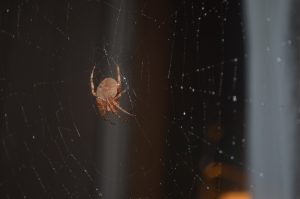
As the calendar turns from September to October, giant webs appear overnight in yards upcountry. These are no ordinary spider webs. They are feats of engineering: perfect, spiraling webs two feet in diameter, strung 10 to 15 feet between trees or from the eves of the roof to the ground. At the center waits a crimson-legged spider ranging in size ¼ to ¾ inch long, not including legs. Every evening the weaver returns and rebuilds her web, much to the chagrin of early-rising humans who head out the door and face first into a spiderwebs.
The spotted orb weaver, known commonly as barn spiders, is an introduced spider in the genus Neoscona. They are one of approximately 205 species of spiders in Hawaiʻi, of which an estimated 77 species have been introduced by people—accidentally or unknowingly over the last few hundred years. The barn spiders are native to many parts of North America—in the east from Florida north to New England and in the west from Arizona, and south into Mexico.
As with most introduced spiders, they probably arrived hidden in cargo or plant material. Luckily, like some introduced species, their impact seems to be negligible. They are not particularly venomous and scurry away from people—though humans may scurry faster. Entomologist Mach Fukada with the Hawaiʻi Department of Agriculture first noticed them 20 years ago. He’s not worried but they may have an impact –contributing to an imbalance in the invertebrate food webs. The spider eggs are preyed upon by tiny native flies, and the presence of these introduced spiders may artificially increase the fly population, consequently increasing predation on native spiders.

The spiders native to Hawaiʻi are endemic – all 126 species are found nowhere else in the world but the Hawaiian Islands. The fact that spiders made it to Hawaiʻi without the help of humans is remarkable
Native spiders colonized the islands by drifting here on the wind courtesy of the tiny spider parachutes attached to their young; some even arrived riding debris across the ocean, a few may have come tucked among the feathers of a bird. Thirteen species provided all the genetic material for the resulting in the 126 species native to the Islands, establishing at the rate of a species every 2,310,000 years.
Native spiders tend to live in areas unaltered by people; finding their home in rainforests and mountain tops. The happy faced spider is perhaps the most famous of these; she makes cameo appearances in children’s books and cartoons. She’s rarely seen by most people, living in remote rainforests tucked under a leaf.
Other introduced spiders like the orb weaver and her giant web are far more likely to be the spiders you see. The most common and infamous, cane spiders, garden spiders, spiny backed orb-weavers (often called crab spiders), and false funnel spiders are the common ones, living among our houses and gardens with few impacts. Though they may be unloved, you can at least give spiders credit for keeping insect populations down: cane spiders devour cockroaches and even go after scorpions, hunting them down rather than waiting in a web. Farmers can thank spiders for helping to capture cabbage moths that devour crops. Webs are a secondary screen, capturing pesky mosquitoes.

All spiders have a venomous bite (that’s how they subdue their dinner) but only a few introduced arachnids are harmful. Black widow spiders and the brown violin spider are both present in Hawaiʻi and fairly widespread and dangerous. They hide in dark crevices and avoid people when they can, but their presence warrants wearing gloves when moving wood and other material stored outside.
The introduced spiders present in Hawaiʻi are too widespread to be controlled by any organization or agency. Even black widows are so widespread that they are past the point of control. According to Fukada, spiders—cryptic and often hiding from people—are usually widespread and past the point of eradication before anyone notices them. The best time to stop a harmful spider is before it arrives. A strong, well-funded Department of Agriculture, staffed to inspect incoming cargo, can help as can buying locally.
Interested in what you have around your house and garden? You can find good information and identification help for some of the common spiders online at http://www.spiders.us/species/filter/hawaii/ and find additional resources for identifying poisonous spiders here: https://howigetridof.com/spider-identification/
Lissa Strohecker is the public relations and education specialist for the Maui Invasive Species Committee. She holds a biological sciences degree from Montana State University. Kia’i Moku, “Guarding the Island,” is prepared by the Maui Invasive Species Committee to provide information on protecting the island from invasive plants and animals that can threaten the island’s environment, economy and quality of life.
Originally published in the Maui News on November 13th, 2016 as part of the Kia‘i Moku Column from the Maui Invasive Species Committee.
Read more Kiaʻi Moku articles.
